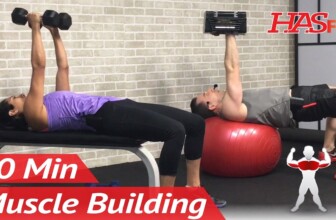Breathing Exercises for Anxiety – Break the Anxiety Cycle 25/30
Discover effective breathing exercises to reduce anxiety—learn diaphragmatic, box, and 4-7-8 breathing techniques to calm your nervous system and break the anxiety cycle.
Join Therapy in a Nutshell’s membership: https://courses.therapyinanutshell.com/membership
You'll get instant access to all 10 life-changing courses, live weekly Q&As, and a supportive community for just $27/month. Learn how to manage anxiety, process trauma, regulate emotions, and build lasting resilience so that you can live a deeply rich and meaningful life!
In this video, you'll explore effective breathing exercises and a deep breathing technique to combat anxiety. The video begins by acknowledging anxiety as a common and treatable condition, emphasizing the role of controlled breathing in calming the nervous system.
The primary focus is on “Breathing Exercises,” simple yet powerful tools to incorporate into your daily life:
Deep Breathing Technique: Inhale slowly through your nose, followed by a slow exhale through your mouth. This controlled breathing activates your body's relaxation response, reducing anxiety.
4-7-8 Breathing: Inhale for 4 counts, hold for 7 counts, and exhale for 8 counts to regulate your breathing and induce relaxation.
Box Breathing: Inhale, hold, exhale, and hold your breath again for equal durations to restore equilibrium.
Belly Breathing: Engage your diaphragm by inhaling deeply into your lower abdomen. This counters shallow chest breathing associated with anxiety.
The presenter encourages regular practice of these exercises and offers tips for integrating them into your daily routines, such as during morning rituals or stressful moments.
Remember, “Breathing for Anxiety” is a complementary tool, not a standalone solution. Seek professional guidance and consider combining these techniques with other therapeutic approaches for a comprehensive anxiety management plan.
In summary, this video equips you with practical tools to manage anxiety through controlled breathing. By focusing on deep breathing and other techniques, it empowers you to regain control over anxiety symptoms, enhancing your mental well-being for daily life.
00:00 Intro
01:30 Breathing Exercise
03:41 Heart Rate Variability
08:15 Benefits
09:10 The Vagal Break
09:57 Belly Breathing
12:35 Paste Breathing
14:25 Slow Breathing
Click the link below to access the transcript:
Breathing Exercise for Anxiety: Calming Anxiety in the Nervous System Using the VAGAL BRAKE
Looking for affordable online counseling? My sponsor, BetterHelp, connects you to a licensed professional from the comfort of your own home. Try it now for 10% off your first month: https://betterhelp.com/therapyinanutshell
Learn the skills to Regulate your Emotions, join the membership: https://courses.therapyinanutshell.com/membership
Looking for affordable online counseling? My sponsor, BetterHelp, connects you to a licensed professional from the comfort of your own home. Try it now for 10% off your first month: https://betterhelp.com/therapyinanutshell
FREE Mental Health Resources: https://courses.therapyinanutshell.com/free-resources
Check out my podcast, Therapy in a Nutshell: https://tinpodcast.podbean.com/
Therapy in a Nutshell and the information provided by Emma McAdam are solely intended for informational and entertainment purposes and are not a substitute for advice, diagnosis, or treatment regarding medical or mental health conditions. Although Emma McAdam is a licensed marriage and family therapist, the views expressed on this site or any related content should not be taken for medical or psychiatric advice. Always consult your physician before making any decisions related to your physical or mental health.
In therapy I use a combination of Acceptance and Commitment Therapy, Systems Theory, positive psychology, and a bio-psycho-social approach to treating mental illness and other challenges we all face in life. The ideas from my videos are frequently adapted from multiple sources. Many of them come from Acceptance and Commitment Therapy, especially the work of Steven Hayes, Jason Luoma, and Russ Harris. The sections on stress and the mind-body connection derive from the work of Stephen Porges (the Polyvagal theory), Peter Levine (Somatic Experiencing) Francine Shapiro (EMDR), and Bessel Van Der Kolk. I also rely heavily on the work of the Arbinger institute for my overall understanding of our ability to choose our life's direction.
And deeper than all of that, the Gospel of Jesus Christ orients my personal worldview and sense of security, peace, hope, and love https://www.churchofjesuschrist.org/comeuntochrist/believe
If you are in crisis, please contact the National Suicide Prevention Hotline at https://suicidepreventionlifeline.org/ or 1-800-273-TALK (8255) or your local emergency services.
Copyright Therapy in a Nutshell, LLC
In this video you'll learn how to use your breath
to calm anxiety using the vagal brake. [Music] Okay. So anxiety is a state of your nervous system.
It's when your autonomic nervous system is activated. This can be triggered by an actual
danger – a real threat in the present moment – but just as easily by a perceived danger- a threat
that you imagine, that you worry about that is so far removed from a physical threat that you don't
even realize why you're having a physical response. The autonomic nervous system is the part of our
nervous system that we don't directly control. That's why you can't just say, “Calm down” and it
works. Except there are people who can. They've literally trained their nervous system to calm
down upon command. So let's explore how you can use breathing to send a message from your body
to your brain that you are safe and turn down the anxiety response. Now, we're going to be exploring
our anxious and calming responses in our body. If you want more feedback from your body you can
get a heart rate monitor or like a smart watch and watch what happens to your heart rate as you
do this. Or as we experiment in this video you can just find your pulse and explore what happens.
Okay so we're going to start by just exploring what's going on in your body. So place one hand
on your chest and one hand on your stomach and take just a few breaths naturally. Just do it
how you would normally breathe. And what do you notice? Which hand moves? For many people, their shoulders lift or their
chest rises and their stomach is tight. For other people, they hold their breath. Notice how
it feels when you're holding your breath. A lot of people hold their breath throughout the
day, and it's something we naturally do when we're scared or tense or uncertain. It's an
aspect of the freeze response. So just notice yourself breathing right now. Okay. Just pay
attention to your heart rate for a second, if you can. Now take a few fast intakes of breath. This is an activating breath.
When we're startled we take a sharp intake of breath. What do you feel
when you do it? For many people this activates. It increases your heart
rate. It's something our body does to prepare for action. So my heart rate
just went up. Now hold your breath and sigh. Like that. This is a natural tension release. It's
built into your nervous system. It releases tension instead of acting it out. So you might
catch yourself doing this when you're feeling frustrated or upset, something like that. Okay. Now
we're going to explore heart rate variability a little bit. And for this one it is pretty important
that you find your pulse. So currently I'm just pushing really gently on my wrist here with two
fingers, and I'm noticing my my heart beating in my wrist. Okay. After you've found your pulse, pay
attention. I'm going to ask you to do a little bit of slower breathing, and I want you to pay
attention to what happens when you breathe in. Try to breathe in for four or five
seconds, and then breathe out for four or five seconds. Close your eyes. Okay. I'm going to have you breathe in for four,
hold for four, and then breathe out very slowly for five. So let's try that. Breathe in 1 2 3 4, hold
for four, 2 3 4, breathe out slowly for five, 2 3 4 5. Okay. We're going to do
that again, and I want you to pay attention to your heart rate when you're in that holding pattern. So
in slowly for four, 1 2 3 4, hold for four, 1 2 3 4, hold and breathe out slowly for
five, 1 2 3 4 5. Did you notice what happened to your heart rate? Can you notice a change in your
heart rate? So breathing in – you might need more time to practice this. And I know this is a short
video, so later you can practice this. But breathing in increases your heart rate. Holding your breath
also makes your heart rate go up. And long, slow out breaths slow the heart rate. They send a message
from your body to your brain to calm down. This is kind of two-directional messaging. Your mind can
tell your body to be activated or relaxed, and your body can tell your mind to be activated or relaxed.
And what you noticed there – when you breathe in your heart rate increases and when you breathe out your
heart rate decreases – this is called heart rate variability – is essentially your vagal tone. And
people who have healthier nervous systems actually have a higher heart rate variability. There's a
bigger difference in their heart rate between when they're breathing in and when they're breathing
out. And we're not going to get all technical on this, but you can use heart rate variability, which
is also known as vagal tone, to measure how strong your parasympathetic response is. Okay. So now
that you've explored how changing your breathing changes your body's state, let's talk about how
you can use your breathing to calm anxiety. Okay. And a quick reminder: like with all aspects of
anxiety, you can't force it. You can't – like if you find yourself trying to force yourself to breathe
deeper or getting anxious about your breathing or struggling against anxiety, like drop the rope. Go
back to your default mode of acceptance, and notice and allow the sensations to be there, and just
say, “Bring it on, body. Bring it on.” Because trying to force yourself to calm down is essentially
telling your body that its own sensations are a threat. It's putting yourself into perceived danger.
If you find yourself thinking, “I can't feel this way. I have to calm myself down,” then you're sending
a message to your brain that you're in danger from your own sensations. So if you find yourself doing
this, take a step back and go back to willingness. You can make space for your feelings. You can feel
them and be okay. Sensations won't harm you. Fast breathing and sweaty hands won't harm you. So that
being said, you can't push a rope, but you can pull it. If you are gentle and compassionate you can
escape the anxiety cycle by using your body to calm your mind and turn on that parasympathetic
response. So there's a lot of benefits training yourself to breathe for anxiety. So New York Times
reports that consciously slowing your breathing to between 5 to 7 breaths per minute at rest can
help reduce blood pressure, regulate heart rate, and lift mood. Researchers have also reported
that breathing slowly can reduce chronic pain, stress, and depression and bolster fitness and
energy levels. One study found that even just focusing on the way you naturally breathe when
paired with other mindfulness practices was as effective as drugs to treat anxiety disorders. So
what's happening here? Your body has a feedback loop. It uses the vagal nerve to send messages
from your brain to your body and from your body to your brain. So when your breathing slows,
it sends a message to your brain that you are safe; you can turn off the anxiety response now.
This reaction is called the vagal brake. So the vagal brake is your body's built-in system to slow
heart rate, lower blood pressure, regulate breathing and digestion, and help you relax. So there's a
lot of things you can do with your breathing, but there are two things I'm going to teach you
right now. You calm your body down in the moment, but the more you practice slow breathing and other
parasympathetic exercises, the more you strengthen your vagal tone. It's like the muscle that you can
use to calm yourself down. And monks who train for hours every day, they can change their heart rate
with a word or a thought. And to a degree, you can learn it too. So let's learn the first most simple
exercise for anxiety, and that's belly breathing. So belly breathing, or diaphragmatic
breathing, triggers the parasympathetic response in your nervous system. So it can be easiest to
learn this exercise when you're lying flat on your back. So I'm going to give you the explanation
of how to do that first. Um you can also learn to do it while sitting in a chair. So lay down flat
on your back. Try to loosen up just a little bit, and place one hand on your chest and one hand
on your stomach. See if when you breathe in you can allow your stomach to raise first before
your chest raises. Feel the difference between breathing with your stomach expanding instead of
breathing with your chest. Okay. The next thing to notice while you're laying on the floor is to
just take really gentle and slow breaths in and out. Breathing in too deeply or forcibly can cause
some people to hyperventilate, so focus more on just allowing your stomach to move gently up and
down, loosely moving without lifting the shoulders. And again, you're trying to get your stomach
to raise first. It's okay if your chest raises afterwards. And if you find yourself feeling a
little bit faint or hyperventilating, try just using slow breathing. You don't
need to gulp in a lot of air and fill up too full. Just slow your breathing
down to four or five seconds per breath. And the other thing to watch out for is
breath holding. So you want to imagine as your breath comes in and out that it's like a wave
going up and down, with a smooth rounded top and bottom. Allow yourself to breathe in and out. Now,
because when people try to practice breathing with their belly they sometimes breathe in
too deeply, we are going to instead focus on my preferred technique for breathing. And you
can do this sitting up or laying down. So my preferred technique for breathing for anxiety is
slow breathing, or paced breathing. And the goal with paced breathing is to simply slow the breath
and lengthen the out breath. And this might take a little bit of exploring to figure out what's
the right pace for you. So we're going to start with counting in for four and then out for six, and
then pause. Um you just want to find the right pace. And again, like I said, if you imagine your breath
as a wave, you want it to look smooth and steady with gentle peaks and valleys, not with sharp
starts or stops or breath holding. And as you breathe slowly, remember to relax your shoulders
and allow your stomach to rise. I'm going to link in the description a couple of videos that will
guide you through this paced breathing exercise. There's also apps you can use. And you want to just
practice this several times a day. I'll link some good ones below. So paced breathing: in for four, out
for six. 1 2 3 4, 1 2 3 4 5 6. 1 2 3 4, 1 2 3 4 5 6. Just gentle
and slow breathing. For some people, they might want to lengthen that to six or seven seconds on each
end, in and out. And for other people, shorter might be better – three or four seconds each direction. Let me
teach you one more way you can use breathing. So if you're non-forceful with yourself, you can use slow
breathing during a crisis or panic. So if you feel yourself getting worked up, you can remind yourself
to breathe slowly and gently. And sometimes this can help you calm down in a stressful moment. Or,
for example, if you're doing exposure therapy work or you're preparing to do exposure therapy work,
like when you're doing imaginary exposure, you can use slow breathing to reduce your anxiety.
Um and the cool thing about slow breathing is it can move your brain waves into an alpha rhythm,
which is like relaxed but alert at the same time. Now again, with all these breathing techniques, we
can't force it. If you find this backfiring, if you find yourself getting anxious when you try to slow
your breathing, take my course on how to process emotions because it means you're getting stuck
in a struggle. Um I've also got a series of videos at the end of this course about how to deal with
panic attacks. Okay. And lastly, it's just important to remember there's a difference between a coping
skill and an exercise. A coping skill might help us calm down in a moment or get us through a
difficult situation, but an exercise is something we need to practice regularly to build up strength.
Um and as I said earlier, you can actually measure the strength of your parasympathetic response,
which is also known as vagal tone, through your HRV. Um we talked about strengthening your
vagal tone on day 22, but the important thing to remember is that if you want a resilient
parasympathetic response, you should practice slow breathing throughout the day. So you want to
trigger yourself to use slow breathing multiple times throughout the day because this trains your
nervous system to have a strong calming ability. So that's what I mean by exercise. We practice calm
breathing multiple times throughout the day, and that strengthens your parasympathetic response.
You shouldn't just wait until you're anxious to try slow breathing. If you do want to practice
this I'm going to encourage you to take a full week where you practice doing slow breathing on
average every 15 minutes throughout the day. You can use the app Lotus Bud to remind yourself to
do this um or some other app that has a reminder. And this is going to be a little bit difficult
at first, but soon it's going to become a lot more natural to notice your state and then trigger
that relaxation response with a few slow breaths. So that's how you use breathing as an exercise
to increase your nervous system's resilience to stress. We can strengthen our vagal tone by
practicing breathing a few times each day. So again, our vagal tone is like a muscle. What we exercise
we get more of. If we exercise our parasympathetic response it will help us get better at calming
down. So it's important that you don't wait until you feel anxious to practice slow breathing. Use
it throughout your day to regulate your nervous system and train your parasympathetic response to
turn on. This is one of the most effective ways to use breathing to manage anxiety. Okay. I hope this
was helpful. Thanks for watching, and take care. [Music]
#Breathing #Exercises #Anxiety #Break #Anxiety #Cycle
source











Improve your mental health with the free course, https://courses.therapyinanutshell.com/grounding-skills-for-anxiety-stress-and-ptsd
Thanks x 1000 ❤
I Believe Your Heart Rate Become’s High.😊
S V R I WINDSHIELD WASHER FLUID
L- V N I C GENETICS / THURMOUN RESPONSE. CARE GIVER. DEHAT LIVER TALL
How often we can do it daily morning and evening …… And pls tell we should avoid it when sensation comes because if we do we simply trigger mind that we are in danger so anxiety loop formed
This was very relaxing and comforting! Thank you so much! I really needed that 💖
Why do you allow translation in other language. So frustrating!!!
I'm 60 and faced an issue of breathlessness on speaking for prolonged duration. I finally discovered that I'm into shallow breathing. Watched & practiced the exercises this young lady has explained. What a wonderful piece of work she has done with a pleasant face. I'm cured now. God bless her!
What if my panic is about not being able to breathe through my nose?
The diaphragm separates the chest cavity from the abdomen. It’s the primary muscle involved in breathing.
Breath with your belly not your chest. When you breath in your belly button should push outwards, and on the exhale should go back the same way it came.
You get deeper breaths using your belly, the vagus nerve runs all the way through your body down to where your intestines are.
Belly breathing stimulates this nerve much more than using the que of chest breathing.
Stimulate the vagus nerve, your body goes into parasympathetic mode.
You can stimulate the nerve in so many ways, from Humming, lightly massaging your eyes (not rubbing, lightly), ice pack to either sides of the neck, etc.
Life is tough but you are tougher. I wish whoever reads this success.
Stick with your plan to beat anxiety and you will succeed.
I can't find the apps for the breathing. If you could send them to me . I could not find the link for them
❤❤❤❤❤❤❤❤❤❤
Please study becoming Muslim .. It will resolve 99% of your problems .. just give it a try .. you will not lose anything!
Nice video but Im beginning to panic attack from mAarijuana and i followed suite and breathed in real quick. it jump started my panic LOL.
The chest and stomach should raise simultaneously! Air goes to the lungs first and chest raises which causes diaphragm to pull down causing the belly to push out (which you're referring to as belly breathing). There are no muscles in the belly that control breathing
This helped me SOO muchhh
Thank you for explaining how this works!🫁😊
Thank you for this❤❤
班代表:
### 總結
在這段影片中,我們學會了如何利用呼吸來平息焦慮,透過調節迷走神經的反應來達成放鬆。影片首先介紹了焦慮是自主神經系統激活的狀態,這可能源於實際或想像中的威脅。接著,講者引導我們通過觀察自己的呼吸模式來了解身體在緊張時的反應。透過一些簡單的呼吸練習,例如腹式呼吸和有節奏的緩慢呼吸,可以幫助我們發揮副交感神經的作用,降低心率、減輕壓力並提供情緒上的穩定。此外,影片提到定期練習這些呼吸技巧可以增強我們的迷走神經張力,使我們能夠更有效地面對壓力和焦慮。
### 精華重點
– 🌬 **呼吸與焦慮的關聯**:焦慮是自主神經系統的激活,可以因為實際或想像的威脅而觸發。
– 💓 **心率變異性**:心率變異性是衡量副交感神經響應強度的重要指標,較高的心率變異性表示更健康的神經系統。
– 🧘 **腹式呼吸的好處**:腹式呼吸(橫膈膜呼吸)能有效觸發副交感神經反應,幫助放鬆。
– 💪 **練習的必要性**:定期練習緩慢呼吸技巧有助於增強迷走神經的張力,提升抵抗焦慮的能力。
– ⏰ **日常練習的建議**:建議每天平均每15分鐘練習一次緩慢呼吸,以培養放鬆的反應。
– ⚖ **應對焦慮的方式**:強調不能強迫自己放鬆,而是應該接受情緒並學會利用呼吸來平靜心情。
– 📱 **使用科技輔助**:可以使用應用程式來提醒自己進行緩慢呼吸練習,提升持續性和有效性。
### 主要洞察
– 🌌 **焦慮的生理反應**:焦慮是一種生理反應,當人體感受到威脅時,自主神經系統會被激活。這包括心跳加速、呼吸變快等反應。了解這些反應能幫助我們更好地識別和管理焦慮。
– 🧠 **心智與身體的相互作用**:身體與心智之間存在著雙向的溝通。當我們的呼吸變慢時,會向大腦傳遞安全的信號,從而減少焦慮反應。這種相互作用強調了身心整合的重要性。
– 🎯 **迷走神經的角色**:迷走神經在調節身體的放鬆反應中發揮關鍵作用。透過呼吸來加強迷走神經的功能,可以幫助我們在面對壓力時保持冷靜。
– 💡 **緩慢呼吸的效益**:研究顯示,慢速而有節奏的呼吸有助於降低血壓、調節心率,並提升情緒。這些生理變化能顯著改善我們的心理健康,幫助我們從焦慮中恢復。
– 🚀 **焦慮管理的長期策略**:將呼吸練習融入日常生活中,不僅能在焦慮發作時提供即時的幫助,還能強化我們的生理應對能力,讓我們在長期內能更好地管理焦慮。
– 🤝 **情緒接受的重要性**:影片強調,試圖強迫自己冷靜下來往往會適得其反。學會接受自己的情緒,然後利用呼吸作為工具來平靜心情,是健康的應對方式。
– 📊 **科技輔助練習**:使用應用程序來定期提醒自己進行呼吸練習,可以幫助我們保持這些技巧的新鮮感,增強持續性,從而更有效地管理焦慮。
這段影片提供了一個切實可行的框架,幫助我們理解焦慮的生理基礎,並通過簡單的呼吸練習來應對和減輕焦慮的影響。透過不斷的練習與接受,我們能夠建立更強大的心理韌性。
My hrv has been very low since i became my mom’s caretaker. It’s as been as low as 12. Average is 18.
This is such a great breakdown of how breathwork directly influences the nervous system! It’s amazing how something as simple as adjusting the pace of our breath can create such a profound shift in anxiety levels. I’ve noticed that even tiny tweaks—like extending the exhale just a bit longer—can make a huge difference in how grounded I feel. Definitely a topic worth exploring more in daily practice! 😊